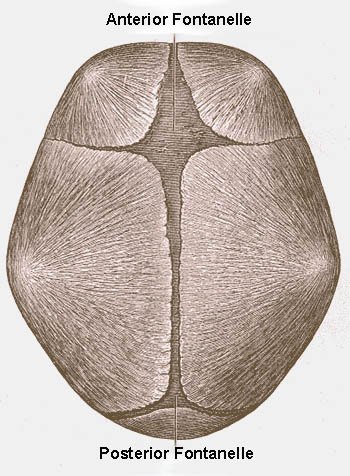The Fontanelle or Soft Spot on a Baby’s Head

Introduction:
What is the Fontanelle? The fontanelle, or soft spot, refers to the areas of the baby’s skull where the bones have not yet fully fused together. These soft spots are present at birth and gradually close over time as the bones of the skull grow and develop. Its position at birth can provide valuable insights into the baby’s well-being and development. In this article, we’ll explore the significance of the fontanelle position during delivery, what it indicates about the baby’s health, and why healthcare providers carefully assess it.
There are typically two main fontanelles on a newborn’s skull:
- Anterior Fontanelle: This is the larger and diamond-shaped soft spot located at the top of the baby’s head, where the frontal and parietal bones meet. The anterior fontanelle is the most prominent and at birth the size usually ranges from 1 to 3 cm. It gradually closes within the first 18 to 24 months of life.
- Posterior Fontanelle: This smaller triangular-shaped soft spot is found at the back of the baby’s head, where the parietal bones and the occipital bone meet. The posterior fontanelle is less noticeable and usually closes within a few months after birth.
What age does the fontanelle close?
- The Anterior Fontanelle gradually closes within the first 18 to 24 months of life.
- The Posterior Fontanelle usually closes within a few months after birth.
Why is the Fontanelle Important?
Fontanelles are important for flexibility of the skull, allowing the baby’s head to pass through the birth canal during delivery and for accommodating the rapid brain growth that occurs in infancy. They also serve as a useful indicator of hydration and intracranial pressure in newborns, as a sunken fontanelle can sometimes be a sign of dehydration, while a bulging fontanelle may indicate increased pressure within the skull.

Vaginal Examination during Labour
During labour a doctor or midwife may do a vaginal examination to assess progress of the labour. The two most important factors in the assessment are –
- How dilated is the cervix – fully dilated is 10cm.
- The position of the baby’s head which is assessed as the position of the anterior fontanelle in regard to the mother’s pelvis.
Is it OK to touch the fontanelle?
You will not hurt your baby by touching their fontanelle, patting their head or washing their hair. However parents and caregivers should handle the baby’s head with care and avoid putting pressure directly on the fontanelles to prevent injury. Additionally, regular monitoring of fontanelle size and appearance during routine paediatric check-ups can help ensure healthy development and early detection of any potential issues. If there are concerns about the fontanelles closing too early or too late, it’s important to consult a healthcare provider for evaluation and guidance.
Recent Posts
- The Differences in a Twin Pregnancy: What You Need to Know
- What is the significance of bleeding at different stages of pregnancy?
- How to Cope with Claustrophobia: Effective Strategies for Managing Anxiety
- 50 Great Bible Quotes Relating to Pregnancy
- 10 Tips for Getting a Baby to Sleep
- How Much Sleep Does a Baby Need? A Comprehensive Guide for New Parents
- How to Make Money with ChatGPT: A Comprehensive Guide
- Unexplained Infertility: What Can You Do. Advice and Guidance
- The Benefits of Mindfulness: A Practical Guide to a Healthier and Happier Life
- Constipation During Pregnancy: Causes, Prevention, and Relief
- Pregnancy Myths, Superstitions, and Old Wives’ Tales: Fact or Fiction
- Endometriosis: The Impact on Fertility and Pregnancy
- Disabled and Pregnant: Equality Problems and Solutions
- Meconium Clinical Significance and Warning Signs
- Hypnosis in Pregnancy and Delivery: A Comprehensive Guide
- Pregnancy Tests: What is Amniocentesis? Your Complete Guide.
- Study at Home for a New Job or New Career: Your Path to Success
- What is Advanced Maternal Age?
- Essential Guide to Changes in Pregnancy
- Buying for a New Baby: The Essentials

Leave a Reply